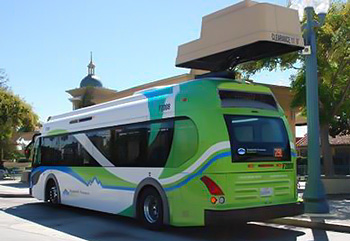Foothill Transit Electric Bus Evaluation

Foothill Transit's electric buses recharge at overhead fast chargers along Route 291,
the transit agency's fully electrified bus route.
Photo by Leslie Eudy, NREL
NREL is evaluating the in-service performance of 12 fast-charge battery electric buses compared to conventional compressed natural gas buses operated on similar routes by Foothill Transit in West Covina, California.
Launched in 2015 in conjunction with a previously funded California Air Resources Board research project, this study aims to improve understanding of the overall usage and effectiveness of fast-charge electric buses and associated charging infrastructure in transit operation.
Foothill Transit has fully electrified one route in its service area and is investigating the feasibility of electrifying other routes as well. The electric buses under study were Proterra EcoRide BE35 transit buses with eight 368V lithium-titanate battery packs offering 88kWh of energy, which can be completely charged in less than 10 minutes via two 500kW fast chargers located mid-way along the route.
The on-road portion of the evaluation focuses on collecting and analyzing vehicle performance data from the electric buses and the conventional buses. Based on the field data, NREL will develop a validated vehicle model using the Future Automotive Systems Technology Simulator, or FASTSim, to study the impact of route selection and other vehicle parameters. NREL will also analyze the infrastructure requirements and grid-side impacts of the high-power charging stations. In addition, NREL will conduct chassis dynamometer evaluation of the vehicles to determine the fuel economy and emissions impact of the electric bus technology in a controlled setting.
Initial results indicate that the electric buses offer significant fuel and emissions savings compared to similar conventional vehicles. The final results will help Foothill Transit determine other possible routes suitable for electrification and provide unbiased technical information to other parties interested in adding such vehicles to their fleets.
Publications
The following documents provide more information about the study.
- NREL Evaluates Performance of Fast-Charge Electric Buses
- Fast-Charge Battery Electric Transit Bus In-Use Fleet Evaluation
- In-Use Fleet Evaluation of Fast-Charge Battery Electric Transit Buses
- Project Startup: Evaluating the Performance of Electric Buses
- Foothill Transit Battery Electric Bus Demonstration Results
Share
